MicroSD Series, Created from a Blank Canvas
That seemed - SD-memory cards. Invented 20 years ago, they began to be sold - a little later, they were used everywhere, they decreased twice in size - first to the Mini-format, and then to Micro. During life, they grew in volume ~ 2,000 times, what more could you want? That's right, increase the speed of work. And reasonable prices. Both have new Kingston lines. And they finally put things in order - instead of a dozen options, there are only three left. Tempting?
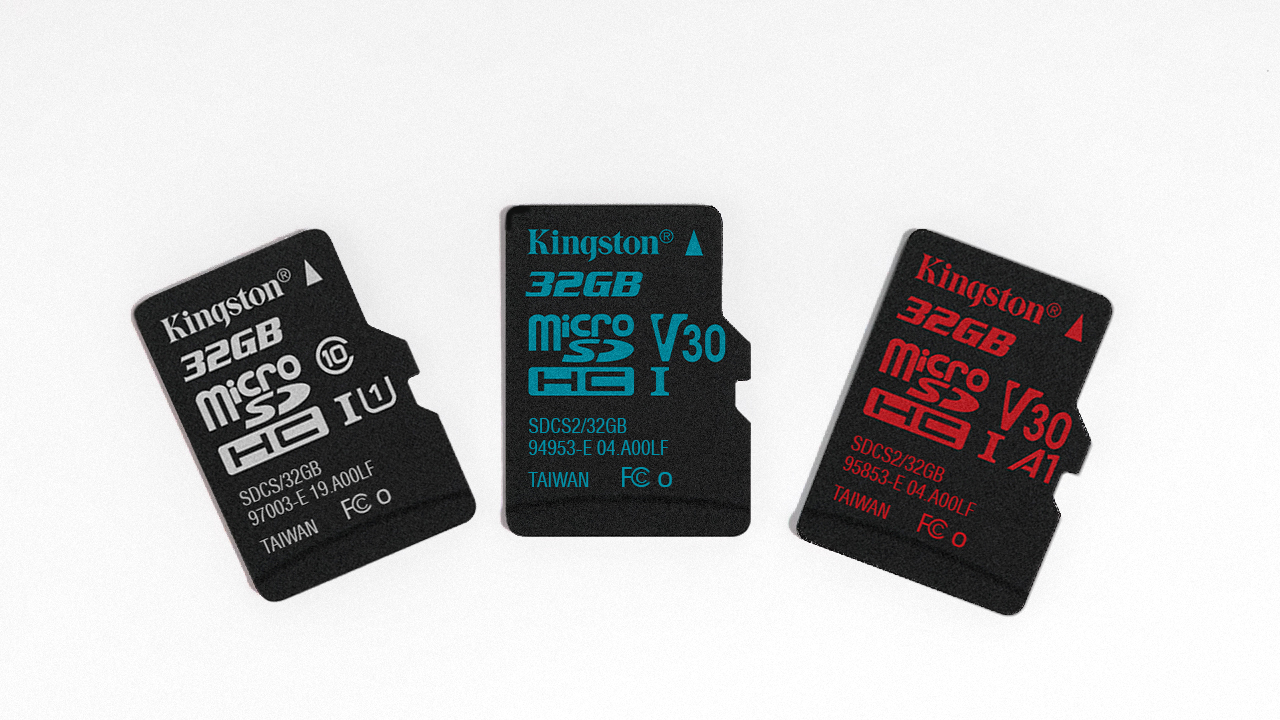
The requirements for SD when creating the standard were the following: to provide backward compatibility with MMC cards, to increase the capacity and mechanical strength of the carrier.
Under the hood - NAND-flash memory, which can be divided into several types. Has it become obsolete in 20 years? But how to say, the technology is, of course, not new, and overgrown with many “crutches” (all for the sake of increased speed and density of information storage), but relevant as never before. Vaughn, HDD trying to retire to send with her help that year.
And it has not reached its limit yet - today, it is equipped with ultra-high-speed NVMe-drives, which, thanks to a powerful controller and connection via the PCI-Express bus, can produce space speeds: up to 3.5 GB per second when reading and up to 2.7 GB per second for writing. But after a couple of years they will seem slow!
The mess in the product lines is a legacy of the era of “hot opposition”. There used to be a lot of brands, but now it has become even more. Everyone wants to stand out, gain a foothold in a particular market segment, create a "special" line and promote it. For each such attack by small manufacturers, large companies produced an answer for an answer - the portfolio of “unique” SD cards grew and grew, even if there was really no difference between them. And this is even if you do not take into account the many brands, little-known in our country, whose products can be ordered on all well-known trading platforms.
If several years ago we could have chosen any favorite memory card in the store and used it in our device, now the situation has changed radically. The reason is that now even smartphones can shoot high-quality video at a speed of 60 or even 120 frames per second. And this requires a good memory card, otherwise there may be errors or so-called friezes during recording. That is, there is no question of any universality. After all, if you are the owner of a budget smartphone, the camera of which is not capable of much, then you don’t need to overpay for excessive performance. And it is the consumer in this case that dictates the rules to manufacturers - we need certain memory cards for certain devices. And manufacturers began to offer solutions for different requirements.
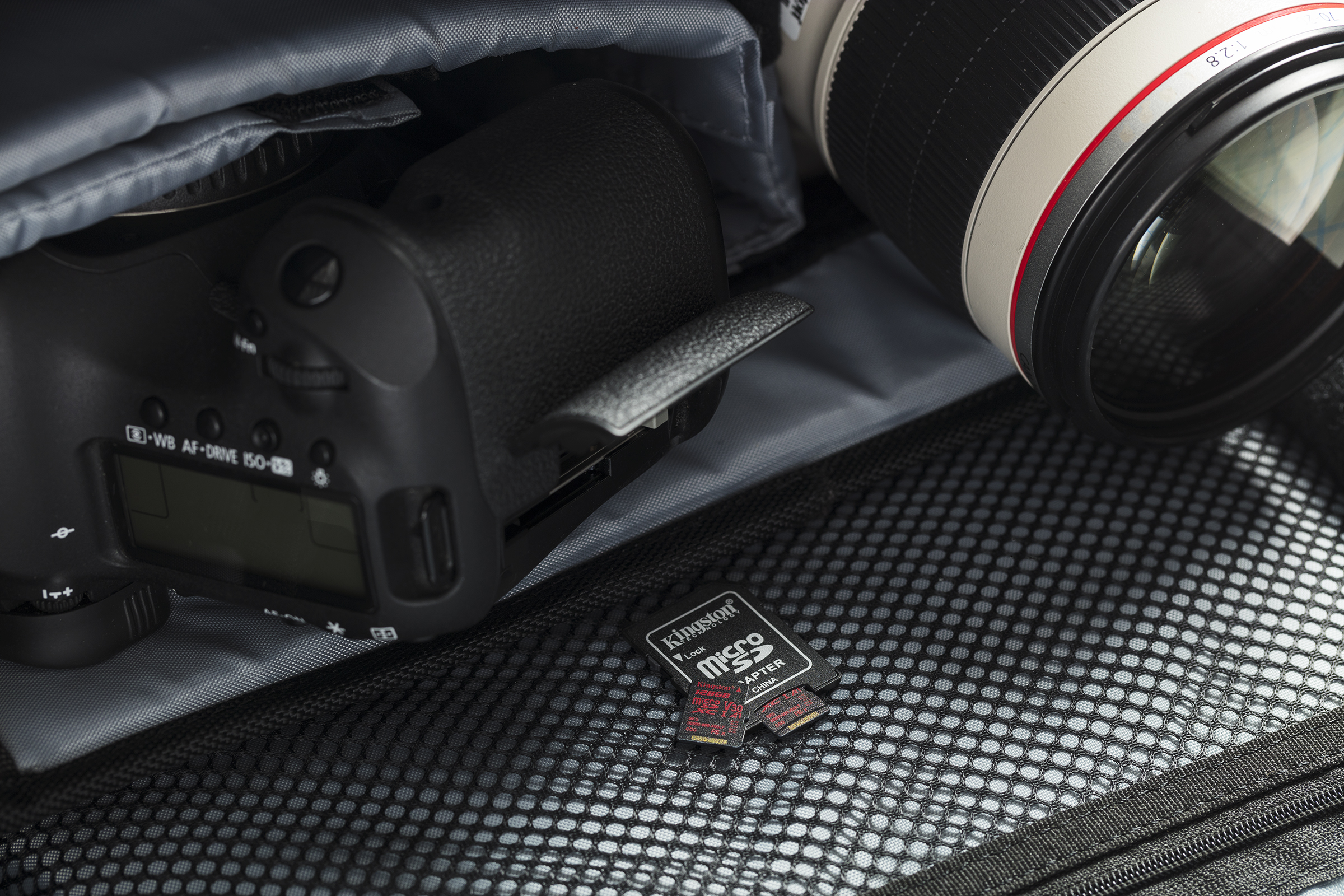
But bad luck - an unprepared user, even if he knows the approximate scope of the future purchase, looks at the box with a memory card, and there appears a whole set of alphanumeric class names like 10, A1, V30 and others. Now we will deal with this.
Previously, there were only class X designations, where X is a number indicating the value of the minimum established writing speed in megabytes. Additional classes A, U and V do not partially replace the class, but their scope is much broader. For example, class 6 is equal to V6. And class 10 is equal to U1 and V10. Everything is logical and not so difficult.
Now about the letters themselves. A - Application Performance Class. It is one of the newest standards and means that memory cards of these classes (for the time being there are only two - A1 and A2) can be used in smartphones as memory for installing on them and running applications from them. The difference between A1 and A2 is not in the minimum established recording speed, but in IOPS - the number of operations per second. These values are set at 1500/500 and 4000/2000 IOPS for reading / writing A1 and A2, respectively.
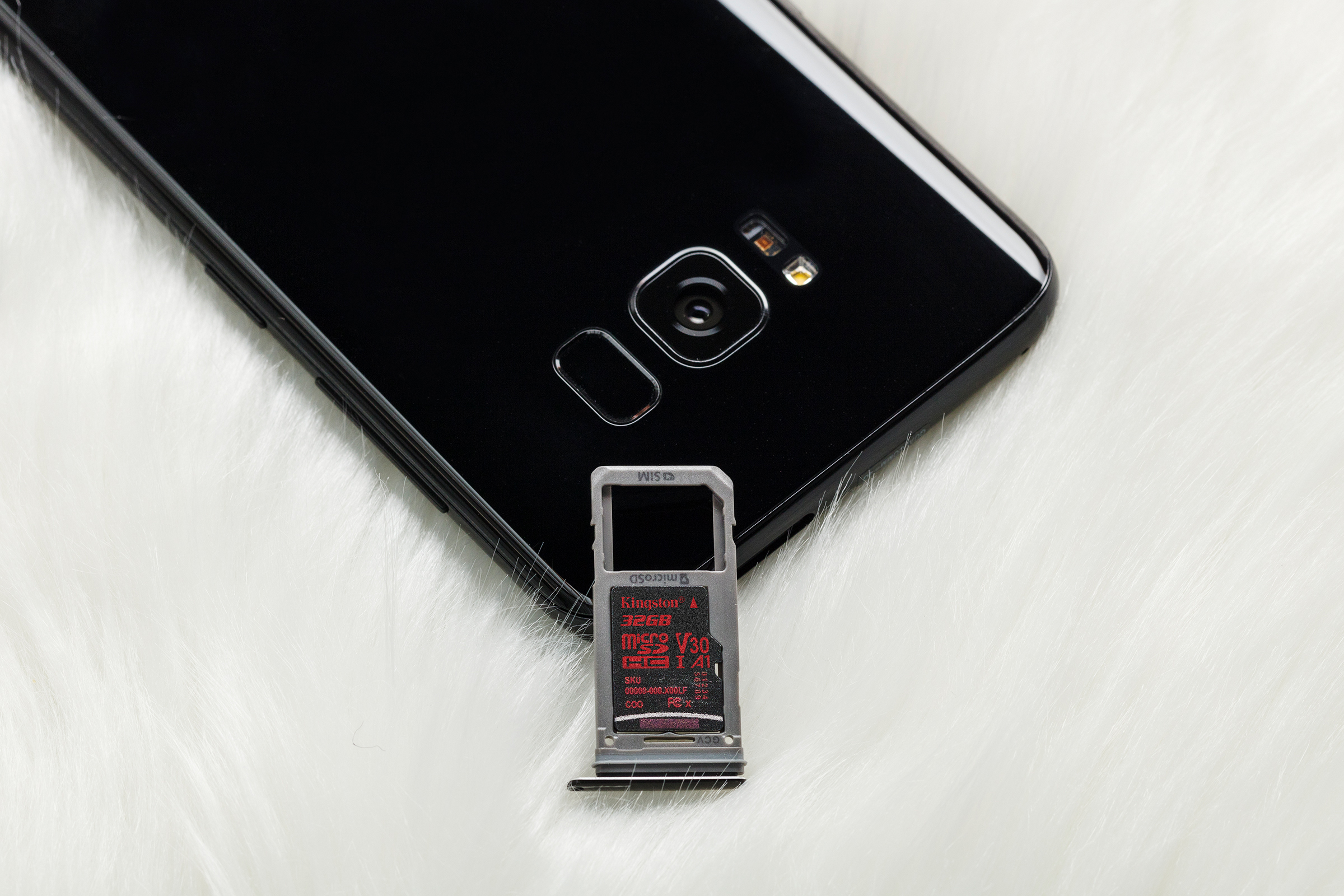
The U designation tells us that the memory card is based on the high-speed UHS bus, and not on the “standard” Normal Speed or High Speed. The U1 class tells us that the minimum established recording speed is 10 MB / s, which allows us to write, for example, FullHD video. A class U3 - 30 MB / s. This is already suitable for recording 4K video.
And now about the letter V - Video Speed Class. Memory cards with this classification also tell us about the minimum steady write speed. Video recordings, if you follow the information from the SD Card Association. And this is not just another letter on the case or box. As the name implies, V-class memory cards are designed to record video. But not simple, but massive 4K, 8K and even 360 ° video files. This class now has five standards. And the higher the number in the title is, the better video can be written. It is easy to guess that V90 memory cards are needed for professional equipment, and not for some smartphones there.
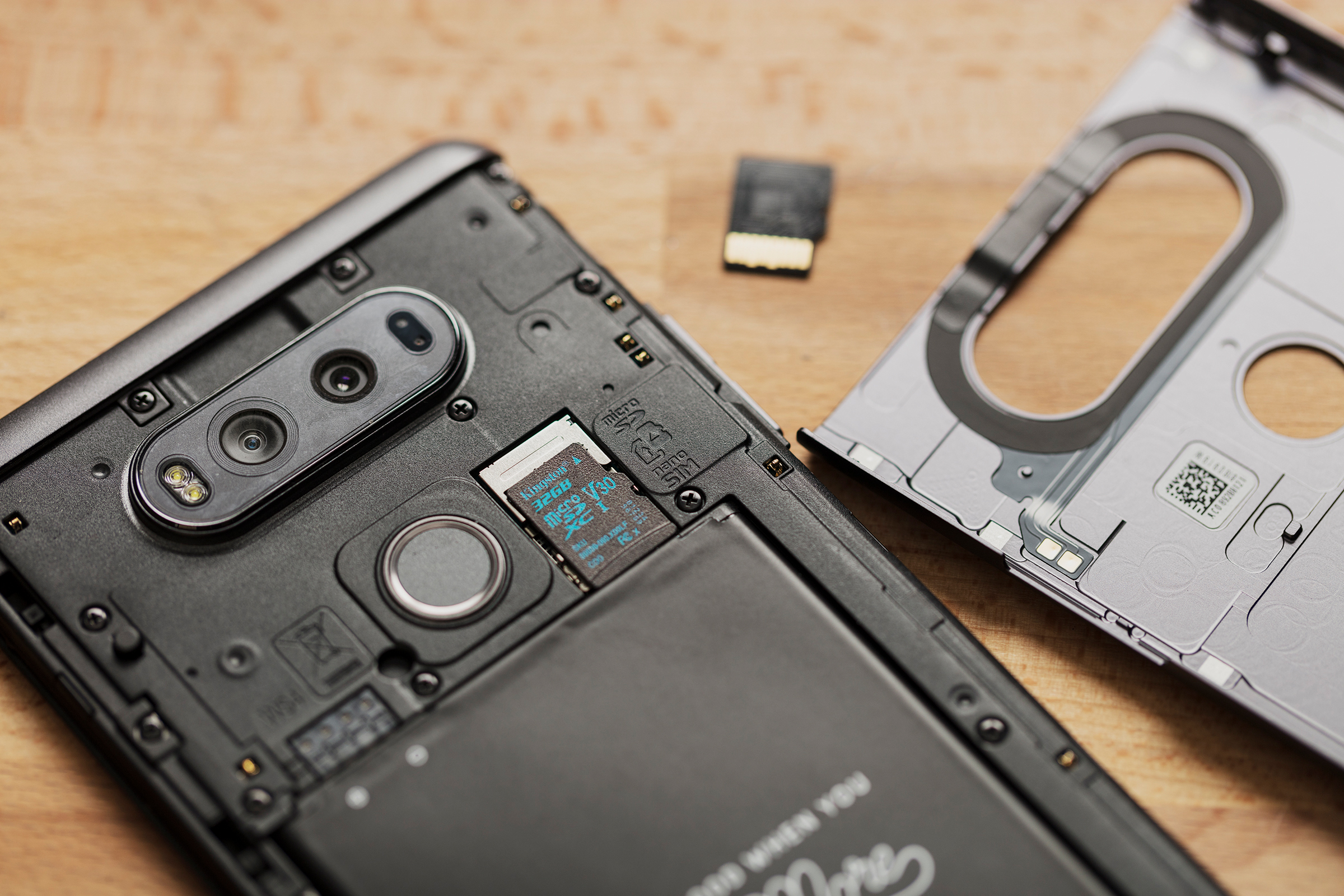
With the classification figured out. Now back to Kingston. The manufacturer offers a series of Canvas, which combines three directions - Select, Go! and React . And they are clearly demarcated. To begin with, we suggest that you familiarize yourself with the test results obtained by many familiar Windows software. Memory cards were connected using a Kingston FCR-HS4 reader.
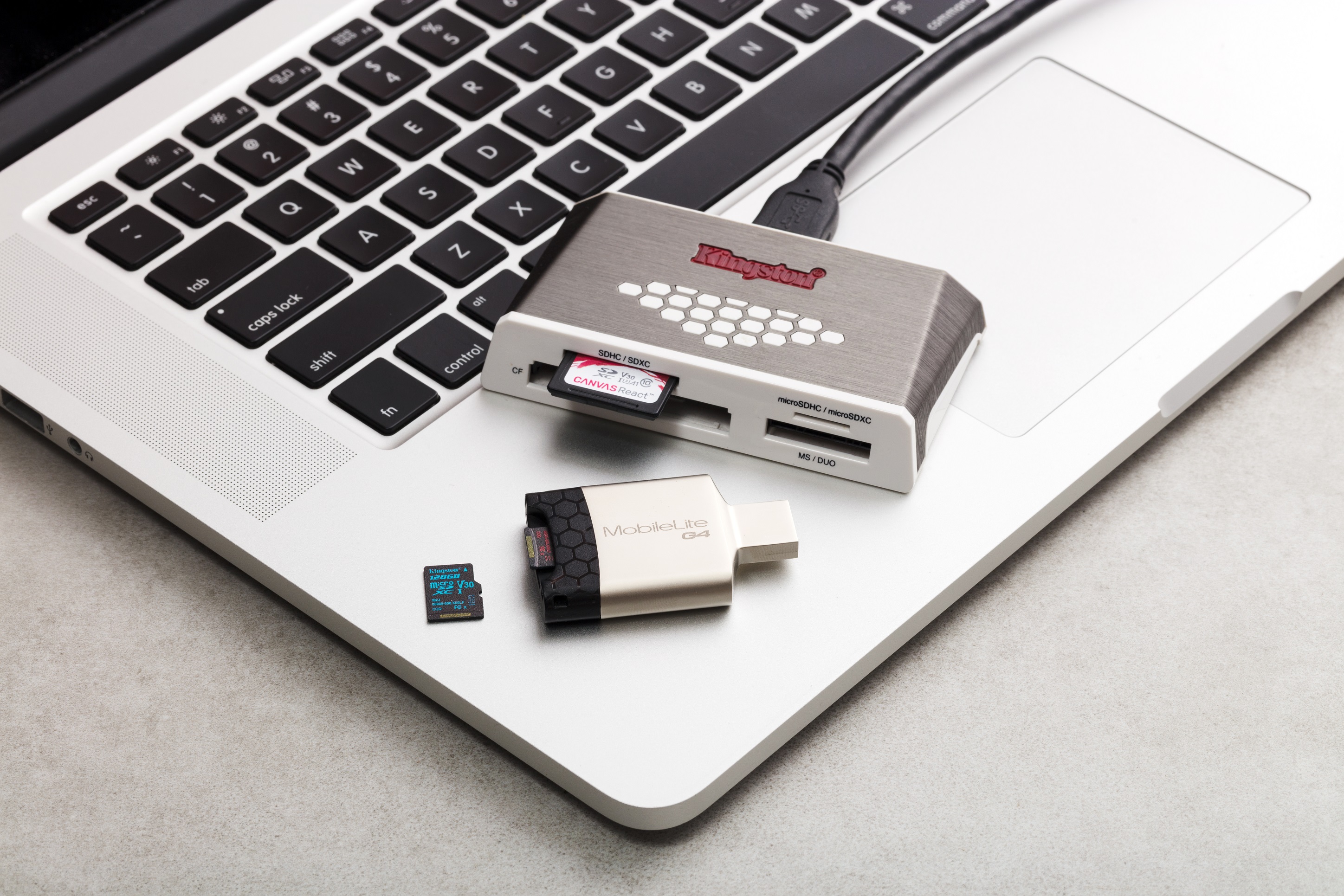
Select memory cards are designed for undemanding users who plan to use them in low-cost smartphones or similar devices, where there are no special requirements - to throw music, write HD video and something like that. These memory cards comply with the class 10 and U1 (UHS-I) standards. Reading speed can reach 80 MB / s. At our booth such a result was obtained for standard operations - reading and writing one large file, as well as writing and reading more than seven hundred small documents.


As already mentioned, this series of memory cards is not intended for active use, such as video recording. And the resulting recording schedule proves it:
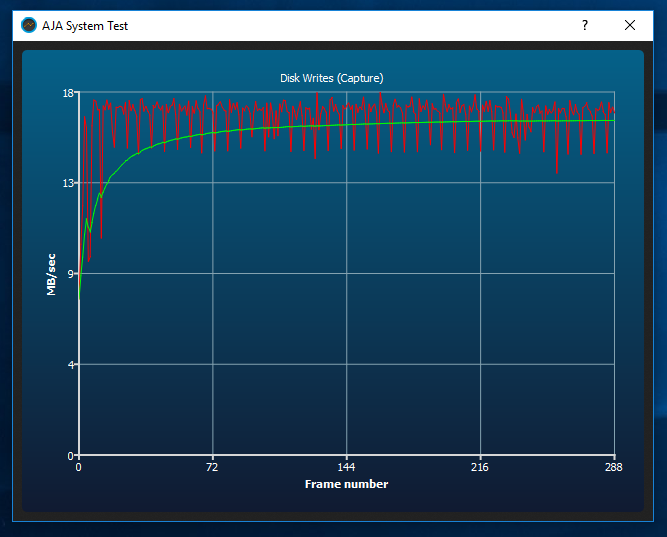
Go line products intended for users who are interested in recording FullHD and 4K video. Memory cards of this line comply with U3 (UHS-I) and V30 standards. In other words, even 4K video with 60 frames per second will be recorded correctly. Not to mention cameras, even smartphones are already starting to support recording video of this format. Reading speed can reach 90 MB / s. Similar testing was carried out:

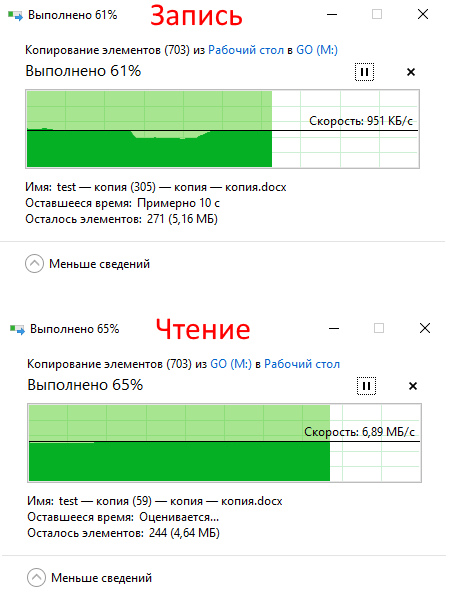
And here there is no problem with video recording. There is no outstanding stability, but we see the complete classification compliance:

And React memory cards are considered the most “fancy”. Not only that they also fully comply with the standards U3 (UHS-I) and V30, and yes even certified to A1. That is, you can install applications or games on them - the memory card will play the role of expanding the built-in storage of a smartphone or tablet. In addition, recording speed is also very important for serial photography - professional cameras can shoot more than a dozen frames per second and when filling the buffer memory of the camera itself, the photos are copied to the memory card. And the sooner this happens, the faster you can continue shooting. And, of course, their reading speed is at an altitude of up to 100 MB / s. And again our results:
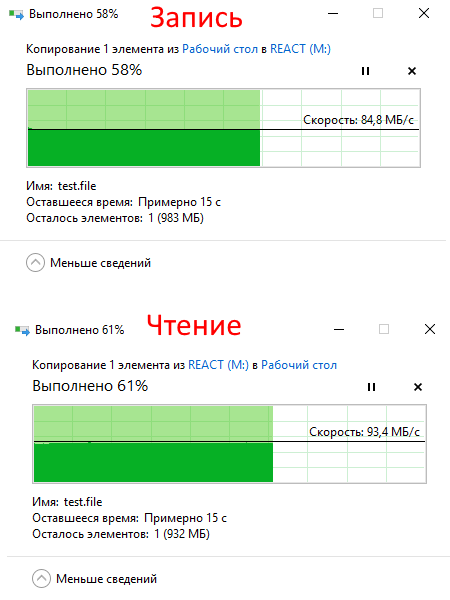

Video is still better:
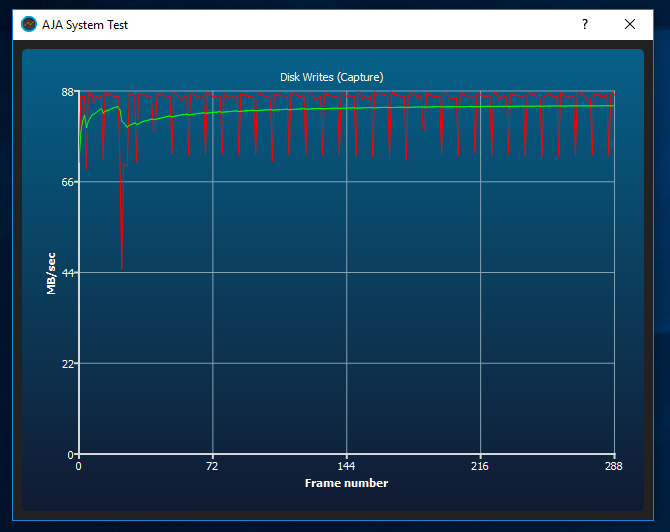
But that is not all. React cards are A1 certified. And this, we recall, means that the IOPS values (the number of I / O operations) for random read / write is 1500/500, respectively. The experimental sample showed excellent results, which significantly exceeds the specified indicators. Slightly lower there will be a visual graph for ease of comparison, but for now the screenshots from the software themselves.

We did not cheat the attention and the other two models to clearly show the difference.
Map Go! demonstrated the result is much weaker:
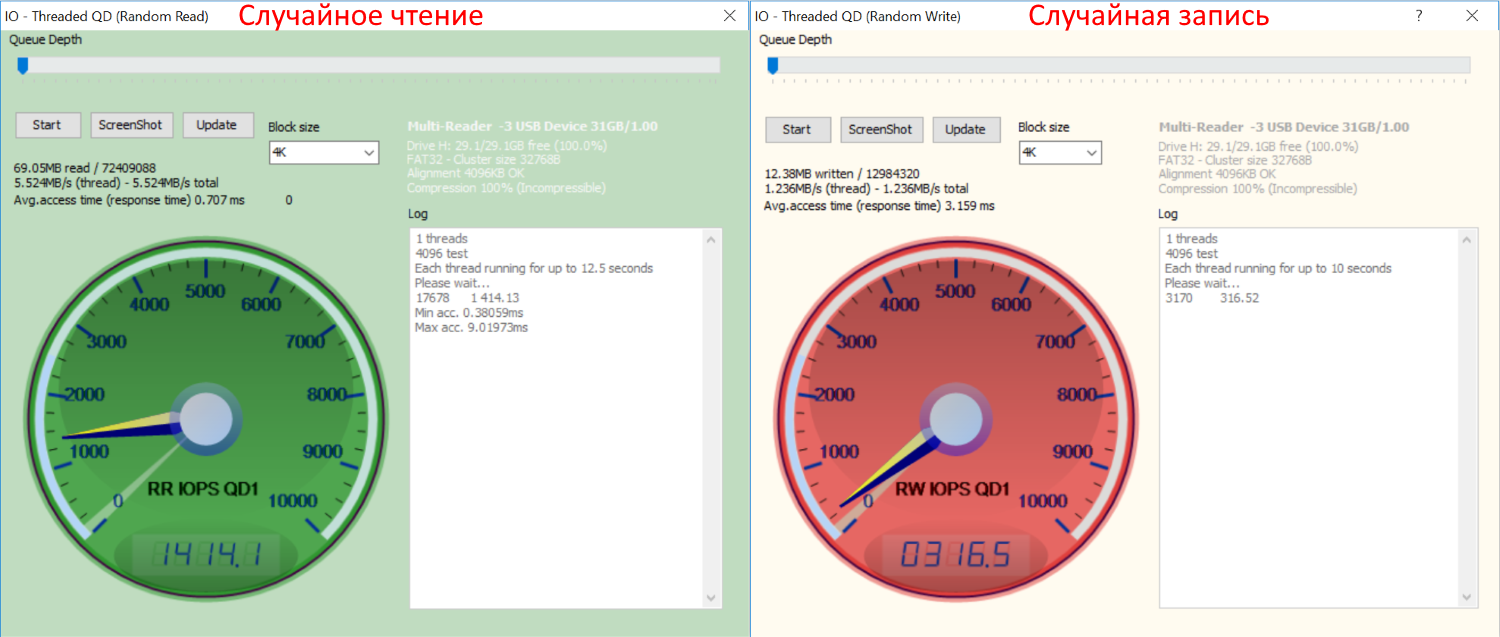
Well, for Select, this test was carried out only formally:
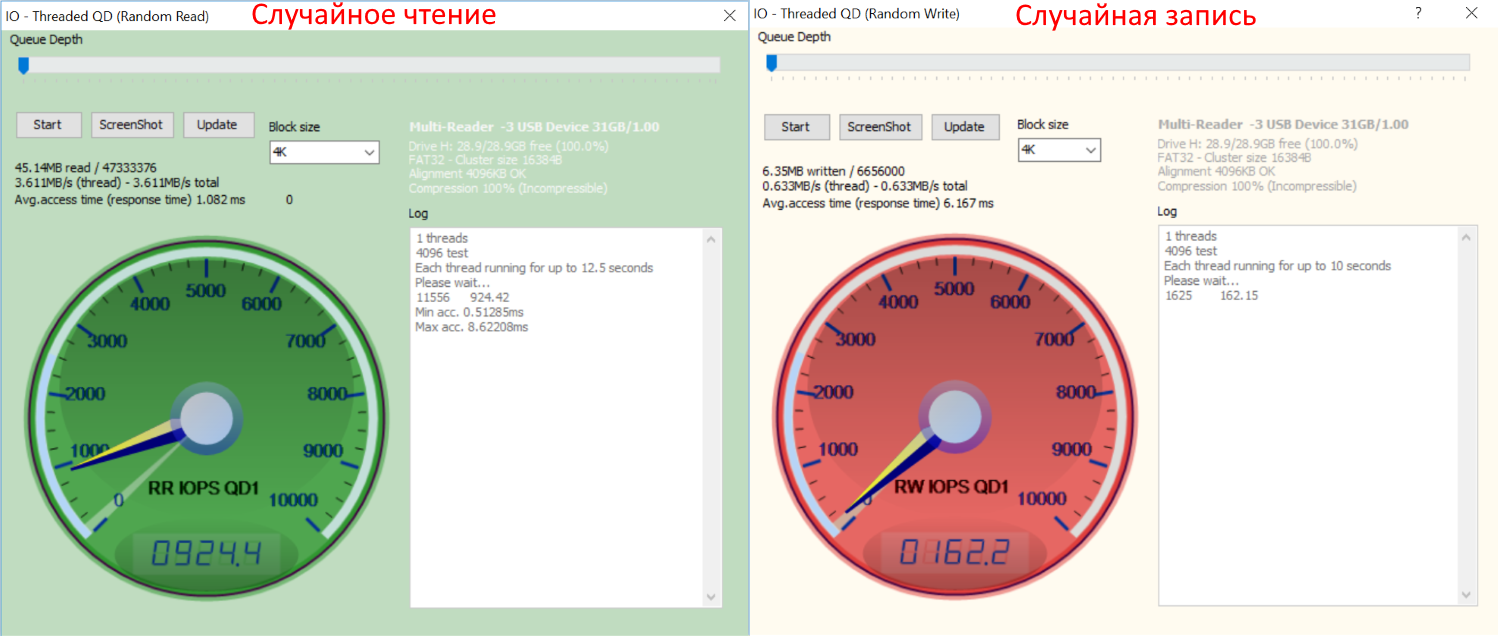
Now, a visual comparison of all these indicators and even a little more.
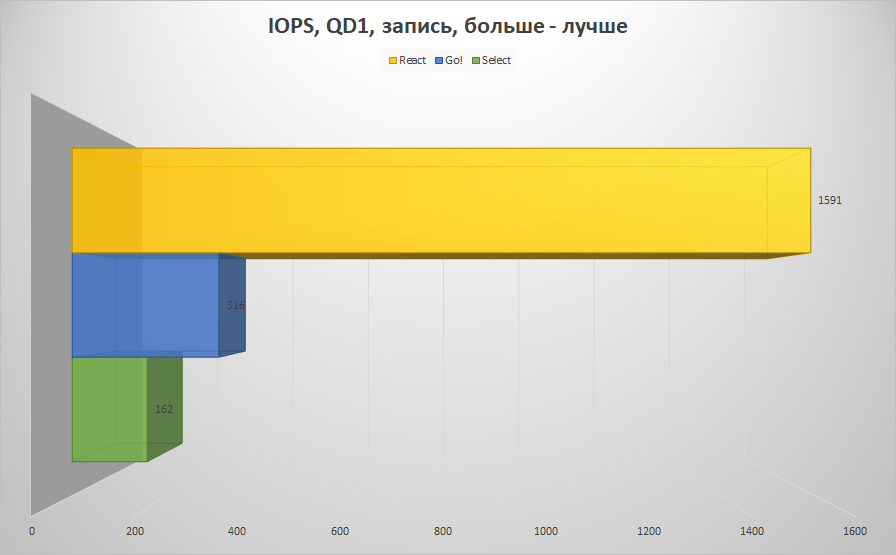
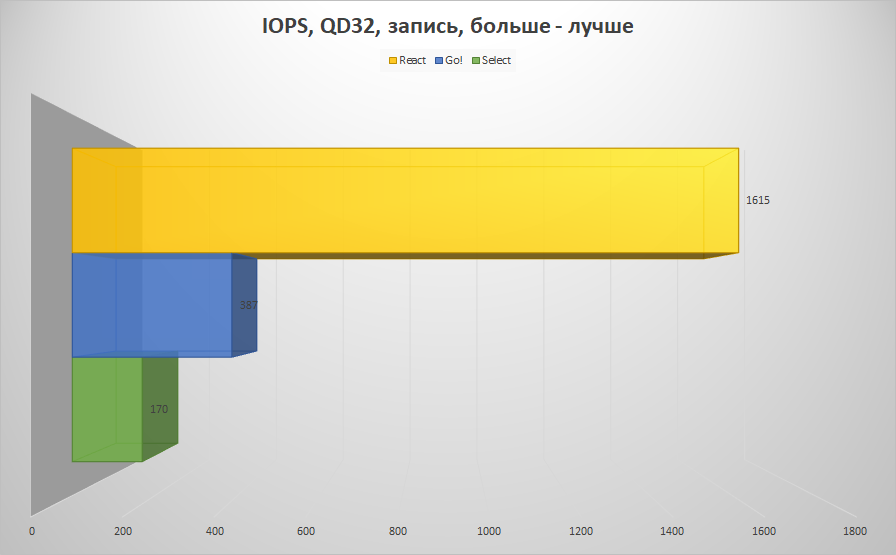
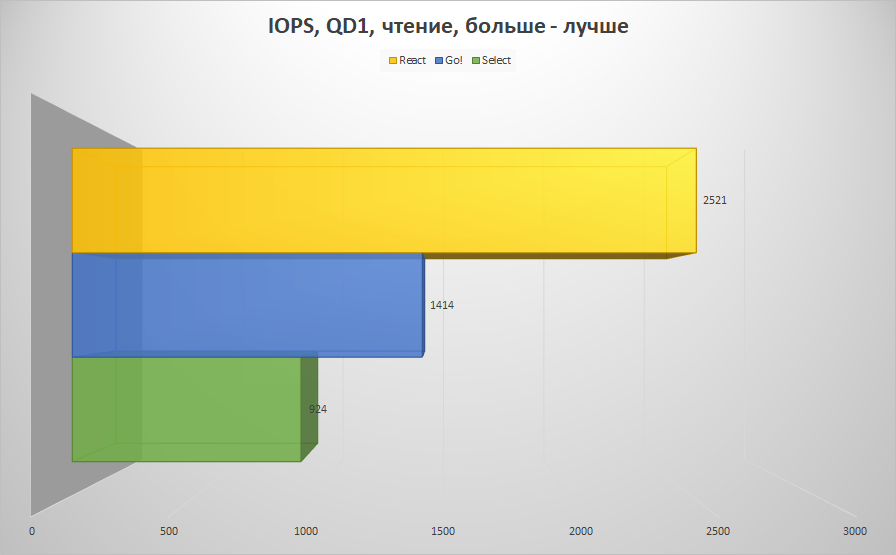
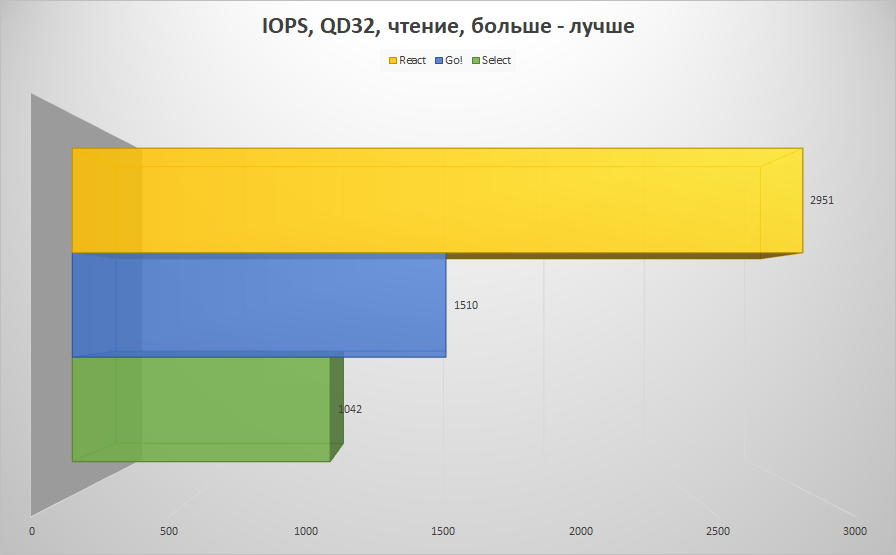
And you need to add more real tests. First, we will reduce the copying and recording tests already demonstrated to a digestible form.
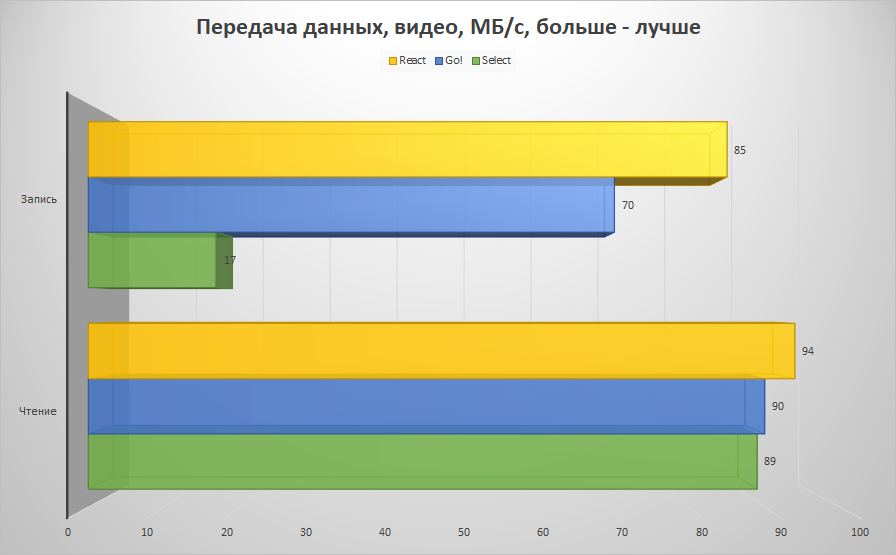
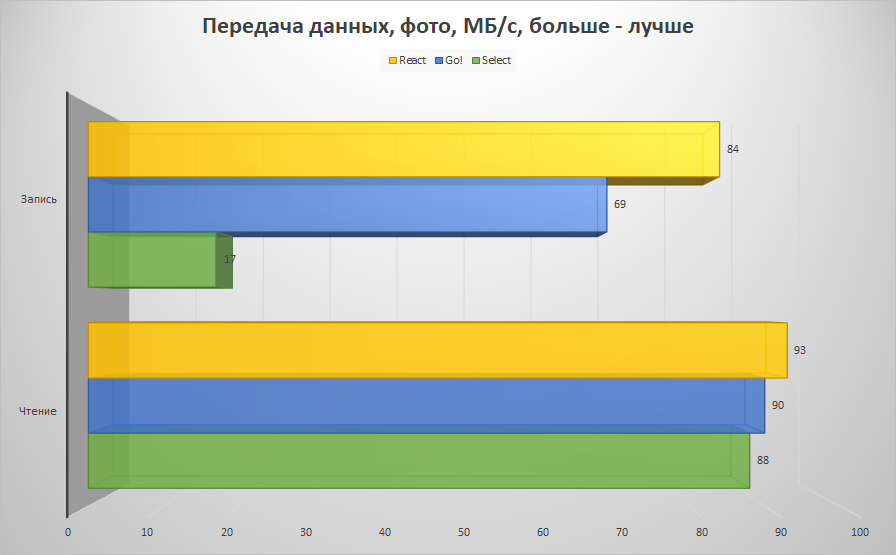

And add information from the real application.
For example, we used Sony A77 cameras, which can record a series of 12 photos, each of which has a resolution of 6000x4000 pixels. When filling its buffer memory, the footage is transferred to the memory card. How long did it take? The results are as follows:
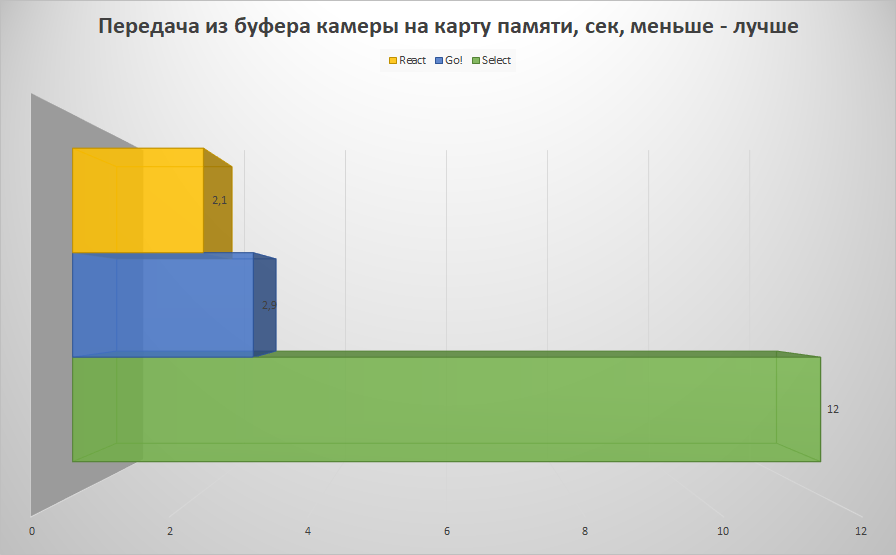
We all often download and install applications. For this test, we took Yandex Navigator, which takes almost 100 MB in packaged form. The installation time on the memory cards was as follows:
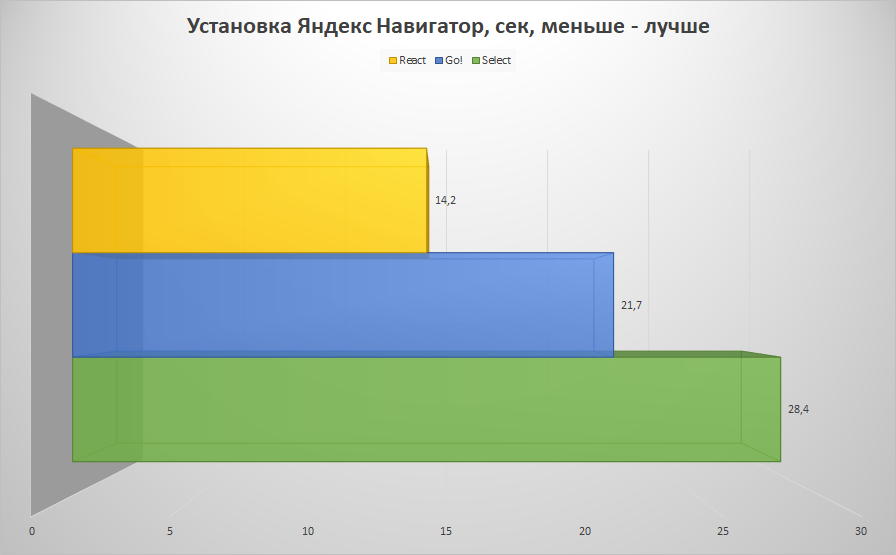
No less interesting and the launch time of the same program. To do this, first maps of the city were downloaded so that the speed of connection to the network did not affect the launch speed. The time from tapping the label to the full interface load is as follows:
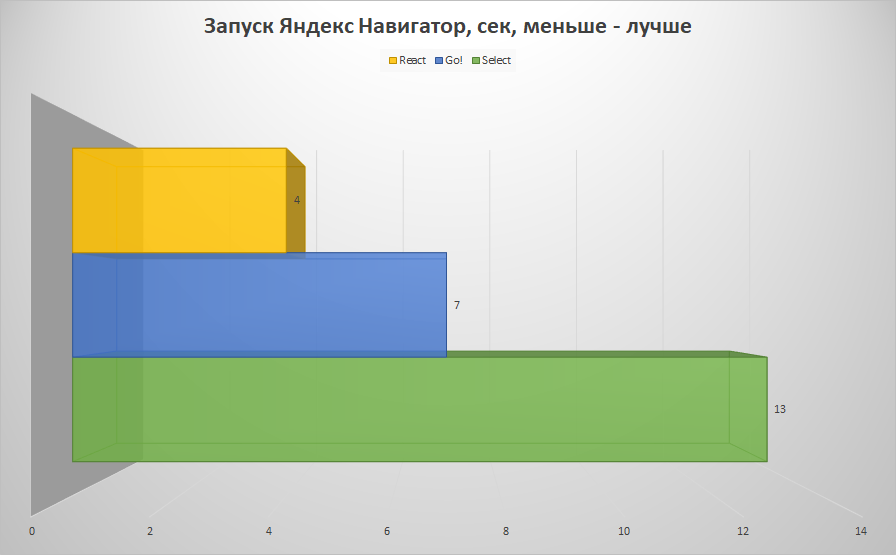
What do we get in the end? Namely, what they wanted earlier - to get the product that is needed precisely for our tasks. For an inexpensive smartphone, Select, for something more serious, Go !, and for advanced equipment, React. After all, it would be strange to put React in a smartphone that is comparable in value to the memory card itself. Yes, and the possibilities would be superfluous. Of course, the pricing policy is also different . But it’s logical that you need to pay more for advanced features. We hope that after reading this material, you will only have to choose the volume of your future memory card, because with the presented rulers everything should be clear!
For more information about Kingston products, visit the company's official website .

What's inside?
The requirements for SD when creating the standard were the following: to provide backward compatibility with MMC cards, to increase the capacity and mechanical strength of the carrier.
Under the hood - NAND-flash memory, which can be divided into several types. Has it become obsolete in 20 years? But how to say, the technology is, of course, not new, and overgrown with many “crutches” (all for the sake of increased speed and density of information storage), but relevant as never before. Vaughn, HDD trying to retire to send with her help that year.
And it has not reached its limit yet - today, it is equipped with ultra-high-speed NVMe-drives, which, thanks to a powerful controller and connection via the PCI-Express bus, can produce space speeds: up to 3.5 GB per second when reading and up to 2.7 GB per second for writing. But after a couple of years they will seem slow!
It was a lot, it became - it is clear ... Not very.
The mess in the product lines is a legacy of the era of “hot opposition”. There used to be a lot of brands, but now it has become even more. Everyone wants to stand out, gain a foothold in a particular market segment, create a "special" line and promote it. For each such attack by small manufacturers, large companies produced an answer for an answer - the portfolio of “unique” SD cards grew and grew, even if there was really no difference between them. And this is even if you do not take into account the many brands, little-known in our country, whose products can be ordered on all well-known trading platforms.
If several years ago we could have chosen any favorite memory card in the store and used it in our device, now the situation has changed radically. The reason is that now even smartphones can shoot high-quality video at a speed of 60 or even 120 frames per second. And this requires a good memory card, otherwise there may be errors or so-called friezes during recording. That is, there is no question of any universality. After all, if you are the owner of a budget smartphone, the camera of which is not capable of much, then you don’t need to overpay for excessive performance. And it is the consumer in this case that dictates the rules to manufacturers - we need certain memory cards for certain devices. And manufacturers began to offer solutions for different requirements.

But bad luck - an unprepared user, even if he knows the approximate scope of the future purchase, looks at the box with a memory card, and there appears a whole set of alphanumeric class names like 10, A1, V30 and others. Now we will deal with this.
Previously, there were only class X designations, where X is a number indicating the value of the minimum established writing speed in megabytes. Additional classes A, U and V do not partially replace the class, but their scope is much broader. For example, class 6 is equal to V6. And class 10 is equal to U1 and V10. Everything is logical and not so difficult.
Now about the letters themselves. A - Application Performance Class. It is one of the newest standards and means that memory cards of these classes (for the time being there are only two - A1 and A2) can be used in smartphones as memory for installing on them and running applications from them. The difference between A1 and A2 is not in the minimum established recording speed, but in IOPS - the number of operations per second. These values are set at 1500/500 and 4000/2000 IOPS for reading / writing A1 and A2, respectively.

The U designation tells us that the memory card is based on the high-speed UHS bus, and not on the “standard” Normal Speed or High Speed. The U1 class tells us that the minimum established recording speed is 10 MB / s, which allows us to write, for example, FullHD video. A class U3 - 30 MB / s. This is already suitable for recording 4K video.
And now about the letter V - Video Speed Class. Memory cards with this classification also tell us about the minimum steady write speed. Video recordings, if you follow the information from the SD Card Association. And this is not just another letter on the case or box. As the name implies, V-class memory cards are designed to record video. But not simple, but massive 4K, 8K and even 360 ° video files. This class now has five standards. And the higher the number in the title is, the better video can be written. It is easy to guess that V90 memory cards are needed for professional equipment, and not for some smartphones there.

Now it is clear.
With the classification figured out. Now back to Kingston. The manufacturer offers a series of Canvas, which combines three directions - Select, Go! and React . And they are clearly demarcated. To begin with, we suggest that you familiarize yourself with the test results obtained by many familiar Windows software. Memory cards were connected using a Kingston FCR-HS4 reader.

Select memory cards are designed for undemanding users who plan to use them in low-cost smartphones or similar devices, where there are no special requirements - to throw music, write HD video and something like that. These memory cards comply with the class 10 and U1 (UHS-I) standards. Reading speed can reach 80 MB / s. At our booth such a result was obtained for standard operations - reading and writing one large file, as well as writing and reading more than seven hundred small documents.


As already mentioned, this series of memory cards is not intended for active use, such as video recording. And the resulting recording schedule proves it:

Go line products intended for users who are interested in recording FullHD and 4K video. Memory cards of this line comply with U3 (UHS-I) and V30 standards. In other words, even 4K video with 60 frames per second will be recorded correctly. Not to mention cameras, even smartphones are already starting to support recording video of this format. Reading speed can reach 90 MB / s. Similar testing was carried out:


And here there is no problem with video recording. There is no outstanding stability, but we see the complete classification compliance:

And React memory cards are considered the most “fancy”. Not only that they also fully comply with the standards U3 (UHS-I) and V30, and yes even certified to A1. That is, you can install applications or games on them - the memory card will play the role of expanding the built-in storage of a smartphone or tablet. In addition, recording speed is also very important for serial photography - professional cameras can shoot more than a dozen frames per second and when filling the buffer memory of the camera itself, the photos are copied to the memory card. And the sooner this happens, the faster you can continue shooting. And, of course, their reading speed is at an altitude of up to 100 MB / s. And again our results:


Video is still better:

But that is not all. React cards are A1 certified. And this, we recall, means that the IOPS values (the number of I / O operations) for random read / write is 1500/500, respectively. The experimental sample showed excellent results, which significantly exceeds the specified indicators. Slightly lower there will be a visual graph for ease of comparison, but for now the screenshots from the software themselves.

We did not cheat the attention and the other two models to clearly show the difference.
Map Go! demonstrated the result is much weaker:

Well, for Select, this test was carried out only formally:

Now, a visual comparison of all these indicators and even a little more.




And you need to add more real tests. First, we will reduce the copying and recording tests already demonstrated to a digestible form.



And add information from the real application.
For example, we used Sony A77 cameras, which can record a series of 12 photos, each of which has a resolution of 6000x4000 pixels. When filling its buffer memory, the footage is transferred to the memory card. How long did it take? The results are as follows:

We all often download and install applications. For this test, we took Yandex Navigator, which takes almost 100 MB in packaged form. The installation time on the memory cards was as follows:

No less interesting and the launch time of the same program. To do this, first maps of the city were downloaded so that the speed of connection to the network did not affect the launch speed. The time from tapping the label to the full interface load is as follows:

Consumer wanted, Kingston company complied.
What do we get in the end? Namely, what they wanted earlier - to get the product that is needed precisely for our tasks. For an inexpensive smartphone, Select, for something more serious, Go !, and for advanced equipment, React. After all, it would be strange to put React in a smartphone that is comparable in value to the memory card itself. Yes, and the possibilities would be superfluous. Of course, the pricing policy is also different . But it’s logical that you need to pay more for advanced features. We hope that after reading this material, you will only have to choose the volume of your future memory card, because with the presented rulers everything should be clear!
For more information about Kingston products, visit the company's official website .
